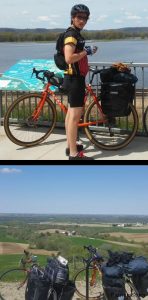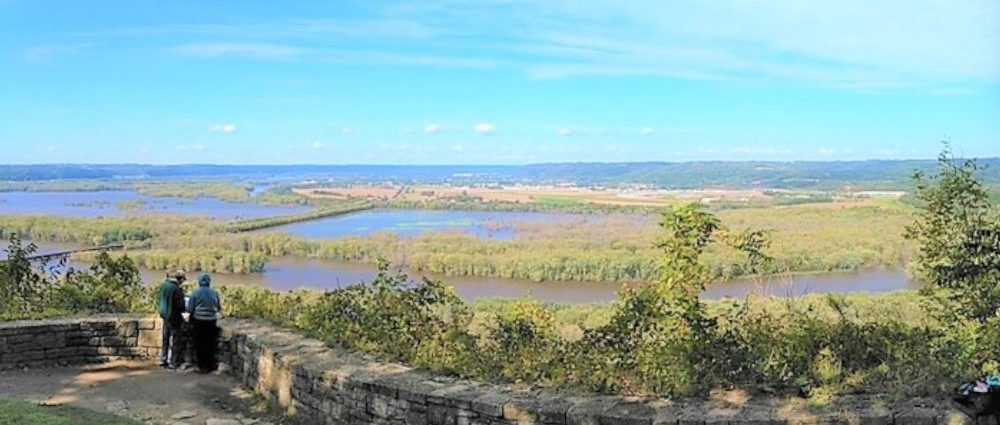Bicycle Touring came into my life during my college years. I attended a small school on Lake Superior’s south shore, where the deciduous and boreal forests meet and mingle. From Northland’s campus in Ashland, Wisconsin, I spent four years in an ever-widening spiral of aimless pedaling. What I found was an abundance of backroads connecting lakes and swamps, rivers and streams, cigarette butts and empty Hamm’s cans, and the smothered remains of the local wildlife.
One dreary afternoon, during my third semester of college, my friend Hal approached me with plans to ride his bicycle down the Mississippi river; I agreed to join before he even invited me. We rode south from Lake Superior, met the river in Red Wing, Minnesota, and followed it all the way to the gulf. The ridiculous—and occasionally regretful—memories, inside jokes, and brief stints of insanity that we shared make for resurgent laughter whenever our paths cross, and I admittedly delight in the brief exclusion of any present third party.
Perhaps my favorite part of the touring experience comes long after the trip is done. Returning to places I first found by bicycle never fails to fill me with nostalgic exhilaration; these places have become sacred to me. Nowhere is this more true than in the Driftless Area, a place worthy of the cliched label “hidden gem.”
by bicycle never fails to fill me with nostalgic exhilaration; these places have become sacred to me. Nowhere is this more true than in the Driftless Area, a place worthy of the cliched label “hidden gem.”
The Driftless Area surrounds the corner where Iowa, Illinois, Wisconsin, and Minnesota converge. This region narrowly avoided the most recent glaciation, and the resulting dramatic terrain is what keeps it hidden from the main flow of traffic. The interstates—like the glaciers—avoided these hills, for passing through them at high speeds is impractical and nearly impossible under certain conditions. Even state highways ride ridgelines and cut through valleys, so that the most charming of the region’s towns are accessible only by county roads with one or two capital letters to their name. There seems to be no method to naming these roads; our route would lead us from T to C to X, which turned into VV much to my confusion.
It was quite literally the high point of my time along the Mississippi. To this day, if I drive in the general vicinity I leave the interstate to revisit the sights I remember most fondly. With a slight flex of the ankle I cruise up hills that I once smeared with sweat, and in my enclosure of steel and glass I don’t even notice the wind that once wore on me. I pull over whenever a memory surfaces, remember gifts of fun and freedom that these roads provided me.
Here, the steep and sudden hills jut out towards the winding road, hiding what’s beyond the next curve from view. Each reveal is greater than the last. Along both the Wisconsin and Mississippi rivers, there are towering bluffs with spectacular vistas of towns tucked between rolling waters and looming cliffs. Prairie du Chien, Wisconsin, is the confluence of these two mighty rivers, where so much yet so splendidly little is happening.
The Tavern downtown is called, simply, “The Tavern.” They serve only canned domestic beers, and feature local musicians every night of the week. The bartender, who is also named Patrick, has canoed the length of the Mississippi and can give useful recommendations to any like-minded river rats passing through town.
Prairie Du Chien to Dubuque via Clayton County Highways X56 and CRY was the hilliest day of our tour down the river with 3,000 feet of climb over the course of 63 miles. We crossed the river for a beautiful uphill grind of a morning featuring a flat tire, derailleur problems, and daunting downhills that made it hard to believe we were in Iowa.
Just after one of these hills was Guttenberg, a small river town where we stopped at a bakery and I realized I had completely lost my sense of time. I supposed we had been at it for maybe an hour that morning—having left at 8:30—but looking at the clock and our map I saw that it was 2:30 and we were well over halfway done with the day’s ride. This raised our hill-weary spirits, so we treated ourselves to not a few donuts.
In the bakery we met a local man who had once sailed all the way around Lake Superior and was very familiar with the Chequamegon Bay, where we had left from seven days earlier. He wished us good luck but warned of a massive climb between Guttenberg and Balltown; the look on his face and the “phews” and “gollies” in his description told me it was a big one.
He was spot-on when he called it a “doozy of a hill.” County Highway CRY curved back and forth, full of little detours and switchbacks but climbing steadily all the while. I could feel my bulging rear panniers dragging me backwards towards the river, begging me to turn around and coast. Each passing motorist gave us looks of genuine sympathy.
When it finally flattened out, we stopped at a parking lot labeled “Scenic Overlook.” From here we could see miles of corn and soy in each direction. The panorama was dotted with silos, and the sky was so clear that I half expected to see Lake Superior on the northern horizon. We hadn’t really noticed the tailwind while we climbed, but now the flat and vacant plateau allowed it to carry us swiftly for three miles to Balltown, where we tried to buy a hearty lunch but were given it for free instead.
The restaurant was called Breitbach’s Country Dining, and due to its hilltop location it is a frequent out-and-back destination for Dubuque cyclists. Long before cycling was popular in the area, however, Breitbach’s was a local favorite. The original restaurant was opened in 1852 and has burnt down twice in its history; both times the rural community of Balltown came together to rebuild their beloved eatery and gathering place. The current owner was a cyclist himself, and though we never saw him in person, he gave the word to our waiter that our meals were on the house. It was a more than sufficient payoff for the climb.
Dubuque is a town full of steep hills and steeped in rich history—from fur trading to steamboat manufacturing to the modern tourism and recreation industry, the story of Iowa’s oldest city has always revolved around the great river. We spent a morning at the Mississippi River Museum, where on the floor was drawn the winding path from Lake Itasca to the Gulf of Mexico. The exhibits followed its course as we learned about the places we had just been and places we would hopefully see soon. After a warm up lap at the museum, we began our first three-state ride: the most in one day until the Lower Mississippi, where the river wriggles and writhes, complicating state borders. We tried to cross into a neighboring state whenever possible, even when doing so required a detour. Each welcome sign lifted our spirits and reminded us how far we’d come; crossing the same river we’d been watching for weeks put the whole blur of an experience into perspective.
Leaving Dubuque behind us, we crossed into America’s dairyland on US Route 20 before veering slightly northwest onto Wisconsin Highway 35, where we were greeted by more abrupt climbs and fantastic unglaciated scenery. After nine miles of riding we found ourselves atop Sinsinawa mound. Sinisinawa is a sacred place long revered by the Mascouten, Ho-Chunk, Potawatomi, Sauk (Sac) and Meskwaki (Fox) peoples. Mandated migrations forcibly evacuated these and other tribes from the valley, following Andrew Jackson’s Indian Removal Act of 1830. In 1847, Roman Catholics settled the area and established a house for Dominican Sisters atop the same ground, which still operates to this day. Whether these new settlers were aware of any past spiritual significance regarding the mound is unclear, but something about the smoothly rounded hilltop and the prairie panorama has long inspired awe and reverence in the people that come across it.
We shared a brief and silent snack atop the mound before riding on through the tumbling terrain, where Green County Highway ZZ looked like a spool of heather ribbon bouncing south towards the state line. After climbing up and down a series of rollers, we checked the map to find that we had crossed the unmarked Illinois border just one mile south of Sinisawa.
Here was fresh air and wide open spaces where ZZ turned to North Menominee Road; the route we had blindly planned for the day far surpassed our expectations. We had veered east enough that the river was out of sight, but there was little to no traffic as we rode along the ridges of mini-mountains, gazing out at the vibrate green waves rolling away in every direction.
I was excited to enter my home state for the first time on this trip; I spent my formative years chasing tailwinds around the corn deserts of downstate Illinois. Since I had spent my college years riding terrain that is—by midwestern standards—pretty hilly, I felt sure I could handle with ease anything that Illinois could throw at me that day. I was dead wrong, and I don’t have much else to say about Chestnut Mountain. We struggled our way up it before turning right on Blanding Road and enjoying yet another rapid descent to the Mississippi River.
Riding through the Driftless, I found places I would ritually return to in the coming years. The bluff country is full of stunning surprises. It is a paradise for any hill-hungry cyclist looking to get away from the swoosh of passing cars behind their left ear, only to exchange it for louder passers by. I had thought of the big river as a highway of our nation’s past, but after riding along the Upper Mississippi it became clear that it is still bustling with commerce and transportation to this day. Already the passing of trains had been constant; they were screaming down a straight shot to the same fabled city we were slowly but surely ambling towards. Their blaring calls from behind startled and upset us at first, but eventually they became something to look forward to; we would take these deafeningly loud opportunities to let out all the screams that had built up like chain rust mile after tiresome mile. It’s good to yell.
Each abrasive train whistle fading away in the distance ahead made us feel slow in comparison, but the barges had the opposite effect. Putzing along the river, their wakes sent gentle ripples along muddy banks as they—and the Driftless Area—disappeared behind us.
2021-03-19


